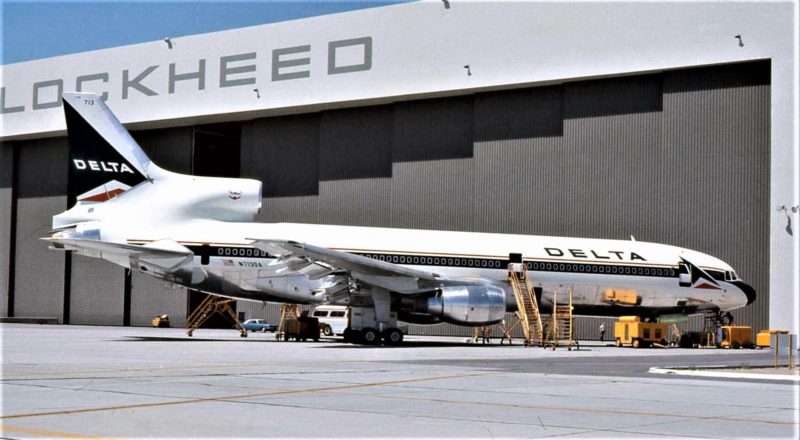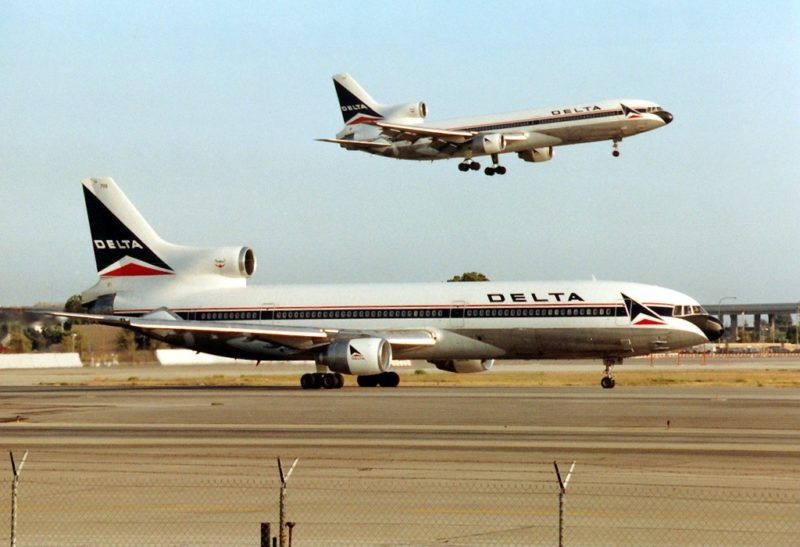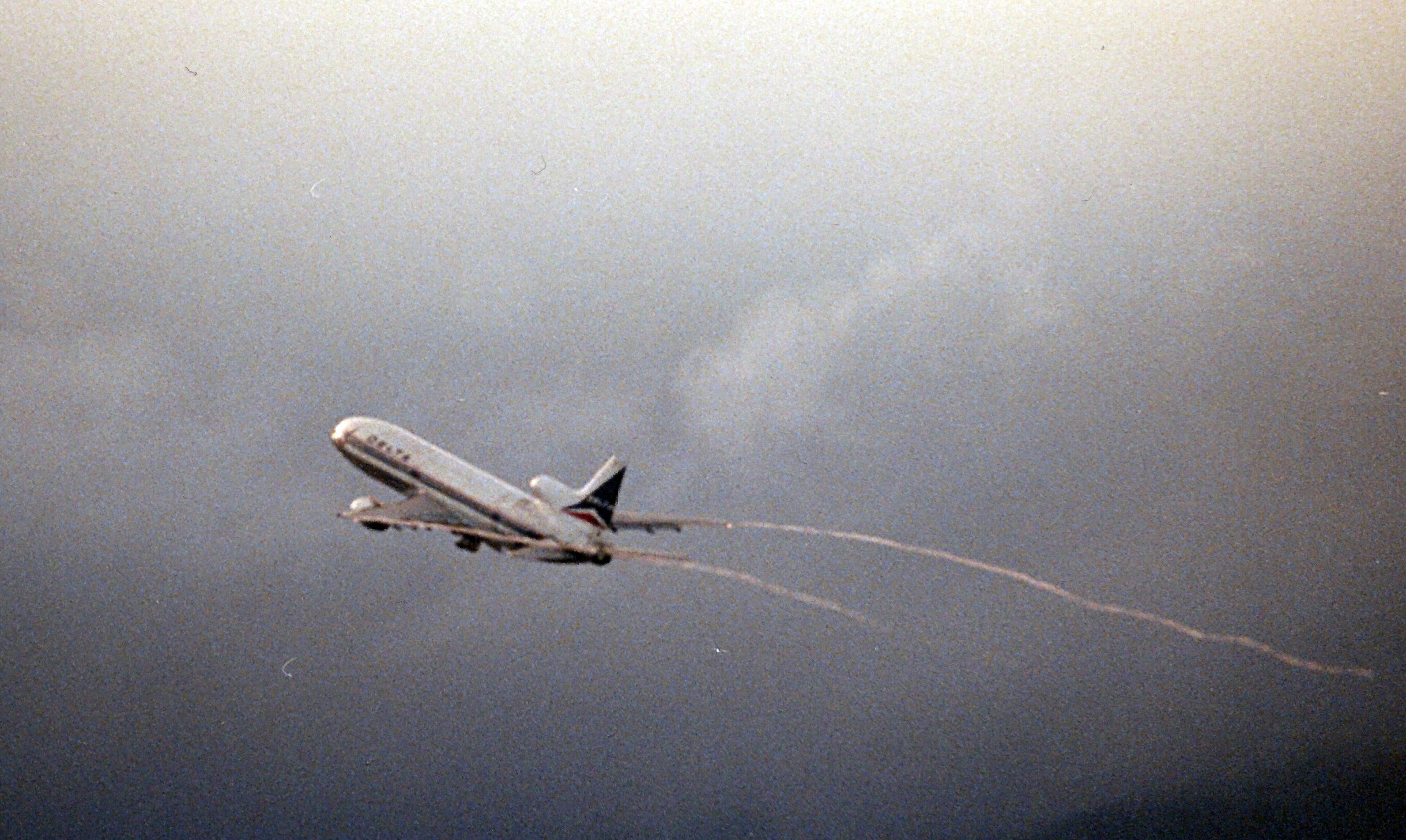Approaching midnight on April 12, 1977, N707DA, a three-year old Tristar 1 operating Delta Air Lines flight DL1080, taxied out for a short late night hop from San Diego up to LAX. Unknown to the pilots, during control checks, the left elevator jammed in the full nose-up position initiating a terrifying hour in dark skies and bad weather with a barely controllable aircraft.
The 41 passengers were tended by eight flight attendants, with Captain Jack McMahon, who wrote an in-depth report for the July 1978 issue of Air Line Pilot magazine, First Officer Will Radford, and Flight Engineer Steve Heidt up front.

During the take-off roll, due to the uncommanded nose up elevator, the aircraft lifted off at 126 knots with no control input, followed by a nose-up pitch excursion that could not be countered by a full nose-down control input by McMahan, who was the handling pilot. Passing 400 feet at 168 knots, he tried trimming nose down but even with full nose-down trim and full forward controls, the lightly loaded jet kept pitching up, with a deck angle passing 18-20-22 degrees, while the airspeed decayed, 150-145-140 knots. The aircraft also exhibited a persistent roll to the left that required, at times, full right aileron input to counter. As the speed kept bleeding off, it became apparent that the aircraft was about to go out of control – a stall, with no available nose-down control authority to recover, would end in a crash in the Pacific Ocean.
McMahan wrote that he was overwhelmed with concern for his passengers, and also that, with the wreckage at the bottom of the Pacific Ocean, the cause would be put down to pilot disorientation during an instrument departure, rather than the dire mechanical difficulties they were experiencing. The week before, a Southern Airlines DC-9 had crashed in Georgia with the loss of 63 lives; the week before that, the Tenerife collision which killed 583. Accidents are said to come in threes, and McMahon thought, we’re it.
These realisations drove a flash of insight. In a counter-intuitive move for a low-airspeed emergency, he pulled the throttles rearward by an inch or two. Lo and behold, their pitch gradually reduced through 20 degrees, with airspeed gradually rising through 140 knots. Thrust was increased on engine number one to counter the persistent left roll. A degree of control over the speed had been regained but the aircraft was still climbing steeply, and would soon bust its 10,000 feet level off clearance. The controller at Coast Approach working the flight was informed of the situation and replied, “We have you on radar and all altitudes are clear. We will stay with you.”
Climbing through 14,000 feet, it became apparent that more action was necessary, or the climb would continue into thinner air and at some unforecast point, they would stall after all, so McMahan further reduced the thrust on engines one and three, which resulted in a gradual pitch change, arresting the climb at 15,000 feet. With constant power changes, a gentle descent to a level off at 10,000 feet and 197 knots was achieved, with an overall power setting equivalent to climb power, which was needed because of the induced drag of the high pitch angle, which was mercifully now stable at around 12 degrees.
Where to Land?
A decision on where to attempt a landing had to be made. McMahan’s two main concerns were either the inability to force the plane onto the runway once it entered ground effect (an invisible cushion of compressed air that forms under the body and wings within half a wingspan of height above the ground), or that the flare would result in a dramatic pitch up that would lead to a zoom climb and unrecoverable stall a few hundred feet above the runway.
Options were scarce as the tanks had only been topped up enough to make the short coastal hop to Los Angeles. Two of McMahan’s options, military and space facilities at Palmdale or Edwards, appealing for their long runways and unpopulated surroundings, closed at 10pm and now, after midnight, would take a while to get staffed and activated. Las Vegas and Phoenix were open with clear skies but required a minimum altitude of 13,000 feet for terrain clearance en route which seemed dicey.

The California coastline was socked in with 700-foot ceilings due to a heavy stratus deck moving onshore, but despite the bad weather, Los Angeles was nominated as it was nearby, the approach was overwater, and it was familiar to all three pilots. An 18 mile straight-in approach to runway 6 Right was requested.
The first flap setting, four degrees, made it possible to recover half an inch of control column movement from the full forward stop, and the next detent, ten degrees, bought them a full inch – significant progress. Established on the glideslope to runway 6 Right with flaps ten, 180 knots and 12 degrees of nose-up pitch, approach checks were completed and for the first time, the crew thought they might have it made. However, extending the landing gear caused a pitch-up, putting the enterprise back in doubt, and abandoning the approach and trying for a water landing in the dark was considered. A radical Hail Mary power change was successful, and flaps 18 was selected, bringing them back onto the glidepath with speed stable at 170 knots. Breaking out of the cloud bank at 700 feet, with the lights of 6 Right ahead and a vertical speed of -800 feet per minute, McMahan vowed to not try for flaps 22 or even much of a flare – “Don’t change a thing, just get it on the ground!”
On-Time Arrival
Touchdown was at 165 knots, 1,000 feet deep into the two-mile strip of California blacktop; the nose stayed persistently skyward to the last, eventually dragged to Earth by heavy main gear braking and full reverse on the hardworking Roll-Royce engines. Flight time had been 55 long minutes. With almost a sense of anticlimax, it was possible to taxi to the gate and the passengers disembarked at their intended destination, and on schedule.
The FAA, the NTSB and Lockheed swarmed over the plane. It turned out that water from rain, fog and mist had dripped down through the structure of the tail onto a bearing. As the plane had repeatedly ascended and descended during its many flights, changes in pressure had sucked the water into the bearing. The bearing corroded and broke. When McMahan checked his flight controls just before takeoff, the elevator, linked to the broken bearing, jammed.
The passengers and even the pilots switched to another Tristar and took off for Dallas, the next stop for DL1080. On the way to Dallas, McMahan received a note from a passenger saying, “All that screwing around in LA is going to make me late for a connection. What are you going to do about it?” McMahan sent word back: I’ll do the best I can.
Cover Image: Wikipedia Commons/Bill Abbott




